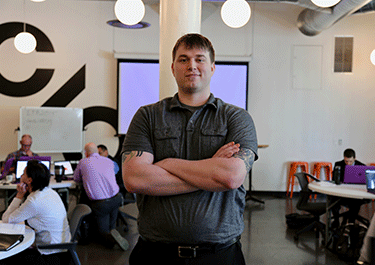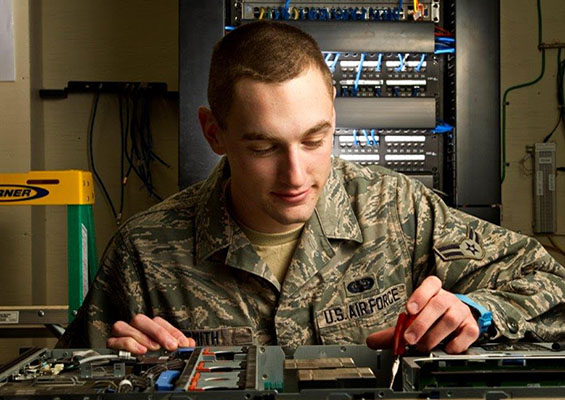 For six years, Brittian McIntosh handled communications for the U.S. Navy. A petty officer, he led a team of personnel responsible for corrective and preventative maintenance on antennas and their associated UHF systems and computers.
For six years, Brittian McIntosh handled communications for the U.S. Navy. A petty officer, he led a team of personnel responsible for corrective and preventative maintenance on antennas and their associated UHF systems and computers.
He could troubleshoot and repair more than 40 different VHF, UHF and EHF systems. Having both secret and top secret clearances to work on encrypted systems, McIntosh was chosen to assist Navy SEALs by setting up private communications between his ship and the rigid hull inflatable boats they used in stealth operations.
In short, he knew his stuff.
“The training I got through the Navy took two full years to complete and is comparable to earning a master’s degree in electronic engineering,” he said. “And I always got great marks in my performance evaluations.”
So when McIntosh exited the Navy with an honorable discharge, management experience, communications expertise, top secret clearance and stellar performance reviews, he expected that his transition into a civilian career would be a smooth one.
It wasn’t.
For starters, McIntosh learned that his broad knowledge of electronics didn’t readily apply to tech job opportunities — or, at least, potential employers didn’t think it did.
He finally found work in Oregon as a field service engineer for a medical imaging company, where he was responsible for maintaining and repairing a network of four types of MRI systems. During his nine months on the job, he responded to more than 100 trouble calls and ensured that his network operated at 98-percent operational reliability, saving customers nearly half a million dollars.
Then new management came into his organization and in a scorched earth manner, laid off everybody who worked there, including him.
McIntosh’s sudden unemployment marked the start of a bleak period in his life.
“My girlfriend and I moved to Oregon thinking our lives were going to be great, and nine months in, I lost my job, I lost my best friend in a car accident, and then my Dad passed,” he said. “It felt like, where is my life going? I was floundering and I really didn’t know how to deal with it.”
McIntosh said that during the next seven months, he submitted hundreds of resumes and cover letters to companies posting job vacancies. He received two phone calls from employers — and didn’t get those jobs.
“I couldn’t figure it out. I was smart. I had all this training, all these skills I could bring to civilian management. I knew I could step in, work hard, teach myself, but I wasn’t hearing back,” he said. “Everyone looks at you like you’re a crappy person for being unemployed. I felt like garbage.”
McIntosh tried enrolling in a local community college. By that time, the high school diploma and college credits he earned prior to enlisting in the Navy were 10 years old, and the community college wanted him to start from scratch.
“Teachers were assigning me worksheets,” he said. “In the military, I was responsible for a team of electronics experts whose work literally meant the difference between life and death. The worksheets felt a little ridiculous.”
It was then that McIntosh revisited the Indeed website to look for new job opportunities and found an advertisement for IT-Ready.
IT-Ready, a program of Creating IT Futures, provides eight weeks of intensive, classroom-based IT education and training free of charge to admitted students. IT-Ready targets people typically under-represented in the tech industry, including displaced or underemployed workers, ethnic minorities and women. Creating IT Futures is a workforce charity founded by CompTIA.
During their training, IT-Ready students learn a wide range of hardware and software skills, including how to build a computer from parts, install new applications, troubleshoot problems, and set up and manage networks. They also cover critical professional comportment skills, such as workplace etiquette, communication, customer service and job interviewing. At the end of their classroom training, students take the CompTIA A+ certification exam.
While McIntosh learned technical skills needed to secure a job within the information technology industry, he says IT-Ready helped him even more by restoring his confidence.
“During my time of unemployment, I really became rather jaded; I didn’t feel like the person I knew I was,” he said. “The most important thing IT-Ready did for me was help me believe in me again. The folks at IT-Ready chose me from a pool of applicants, and had nothing but kind and encouraging words to say to me. It helped me build me back up again.” Upon earning his CompTIA A+ certification, McIntosh secured a position as it specialist mid with ACI Federal in Lexington Park, Maryland, where he works as a contractor at Patuxent River Naval Air Station. ACI Federal is an award-winning, multiple ISO-certified public-services contractor focused on IT, health care and national security initiatives.
The week before he started work, McIntosh said, he had negative $42 in his checking account. Now, he’s earning a respectable salary and working on earning his CompTIA Security+ certification. He sees himself pursuing a long-term career in IT in the field of cybersecurity. “Knowing how my mind operates, security would allow me to use my mind in a fun way so that work doesn’t seem like work,” he said.
For now, he loves the work he’s doing for ACI Federal at the naval air station and is enjoying settling into a life no longer fraught with financial worries.
“This already is the most rewarding job I’ve ever had,” he said. “It’s just a miraculous turn of events and I have IT-Ready to thank for all of it. I am really grateful.”




0